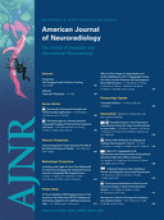Abstract
BACKGROUND AND PURPOSE: Aneurysm clips need to be tested at 3T to characterize MR imaging concerns, including magnetic field interactions, MR imaging−related heating, and artifacts. Therefore, we evaluated these risks for aneurysm clips.
MATERIALS AND METHODS: Three different MP35N aneurysm clips (Codman Slim-Line Aneurysm Clip, straight, blade length 25-mm; Codman Slim-Line Aneurysm Clip Graft, 5-mm diameter × 5-mm width; Codman Slim-Line Aneurysm Clip, reinforcing 30° angle, 6-mm × 18-mm) that represented the largest mass for 155 additional clips made from MP35N were tested. The clips were evaluated at 3T for magnetic field interactions, heating, and artifacts. We studied MR imaging−related heating, placing the clip in a gelled-saline-filled phantom with MR imaging performed by using a transmit/receive radio-frequency body coil at a whole-body average SAR of 3 W/kg for 15 minutes. Artifacts were characterized by using T1-SE and GRE pulse sequences.
RESULTS: Each aneurysm clip showed relatively minor magnetic field interactions, which would not cause movement in situ. Heating was not excessive (highest temperature change, <1.8°C). Artifacts may create problems if the area of interest is in the same area or close to the aneurysm clip.
CONCLUSIONS: The results of this investigation demonstrated that it would be acceptable (ie, “MR conditional” using current terminology) for patients with these aneurysm clips to undergo MR imaging at ≤3T. Notably, on the basis of the sizes of the clips that underwent testing, these findings pertain to 155 additional aneurysm clips made from the same material.
Abbreviations
- ASTM
- American Society for Testing and Materials
- GRE
- gradient recalled-echo
- MP35N
- nickel-cobalt-chromium-molybdenum alloy
- SAR
- specific absorption rate
- T1-SE
- T1-weighted spin-echo
- Copyright © American Society of Neuroradiology












